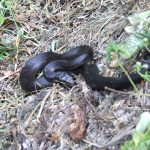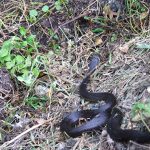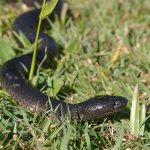SMALL-EYED SNAKE
The Eastern Small-eyed Snake: A Nighttime Hunter of Australia’s Woodlands
In the quiet, moonlit woodlands of eastern Australia, a secretive predator stirs. The Eastern Small-eyed Snake (Cryptophis nigrescens), also known as the Small-eyed Snake, emerges from its daytime shelter beneath rocks, logs, or sheets of bark. With its glossy black scales and a belly ranging from cream to pink, often adorned with dark spots, it moves silently through the underbrush, its small, dark eyes scanning the surroundings.
Physical Characteristics
- Size: Typically measuring around 50 cm in length, though some individuals can grow up to 1.2 meters.
- Colouration: The dorsal (top) side is a deep, glossy black, while the ventral (under) side is cream to pink, sometimes with blackish blotches. This coloration is confined to the ventral scales and does not extend onto the sides, distinguishing it from similar species like the Red-bellied Black Snake.
Habitat and Distribution
The Eastern Small-eyed Snake inhabits a variety of environments, including:
- Woodlands
- Rainforests
- Rocky heaths
- Montane areas
Its range extends along the east coast of Australia, from far north Queensland to southern Victoria.
Behaviour and Diet
As a nocturnal and terrestrial species, the Eastern Small-eyed Snake is primarily active at night. It preys on:
- Small skinks
- Dragons
- Occasionally frogs
The snake is known to shelter under rocks, logs, and sheets of bark during the day.
Venom and Human Interaction
The Eastern Small-eyed Snake is venomous, with a venom that contains a long-acting myotoxin capable of attacking muscle tissue, including the heart muscle, for days after envenomation. While bites are rare and the snake is generally secretive, one recorded human fatality has occurred. Therefore, it’s crucial to exercise caution and seek immediate medical attention if bitten.
Conservation Status
Currently, the Eastern Small-eyed Snake is listed as “Least Concern” in Queensland, indicating a stable population. However, like many native species, it faces threats from habitat loss and degradation. Preserving its natural habitats is essential for maintaining the health of this species and the broader ecosystem.
The Eastern Small-eyed Snake plays a vital role in controlling populations of small reptiles and frogs, contributing to the balance of its ecosystem. Its elusive nature and striking appearance make it a fascinating subject for study and a reminder of the diverse and unique wildlife that Australia harbours.




